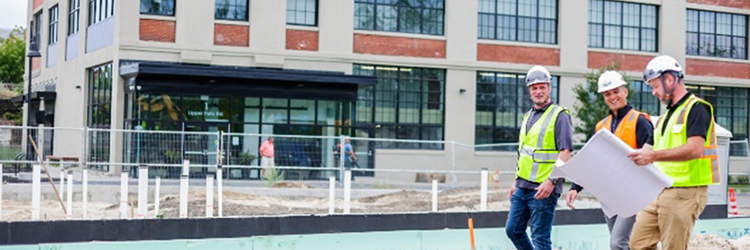Greater Portland industrial market has adapted and prospered despite the pandemic - by Justin Lamontagne

Lamontagne
NAI The Dunham Group
The famous philosopher “Iron” Mike Tyson once said, “everybody has a plan until they get punched in the mouth”. Well, we were all punched in the mouth in 2020 and our plans went kaput. But in a year when everything we knew as “normal” changed, there were some glimmers of continuity in the Greater Portland commercial real estate market, particularly in the industrial sector. Indeed, in large part because of the historical challenges brought on by the COVID-19 pandemic, the industrial sector had another banner year. For the 6th consecutive year, our overall vacancy rate was below 4%. In fact, when we pulled the data in December, our overall rate was a paltry 2.44%.
Beyond the statistics, during the early days of the pandemic, I had a revelation. It dawned on me just how important the industrial market is, not just to property owners and brokers, but to humanity. Many of the Phase I “essential” businesses were industrial in nature. Industries like food production, distribution, utility and manufacturing companies were open and operating, allowing the masses the luxury of staying home and quarantining safely. Thanks to many industrial businesses and workers we flattened the initial curve and some slivers of normalcy remained in our lives.
The ability of the industrial sector to adapt and prosper despite the pandemic-related changes to our world was one of the more fascinating trends to track in 2020. For example, many Maine-based industrial manufacturers pivoted quickly and profitably, producing Personal Protection Equipment for front-line workers. Our beloved craft brewers created alternative purchase options (curbside pick-up is here to stay!). And several leveraged their brewing equipment and knowledge to “craft” hand sanitizers and sprays.
Most impactful, from an absorption and transactional standpoint, was the dramatic growth in local life science and laboratories that focused on COVID-19 testing and treatments. Abbot Labs, in particular, experienced a nearly 300,000 s/f industrial expansion in 2020. In addition, the onshoring of manufacturing work has driven several significant expansions in that sector. So much so that there is a lot of discussion within the sector of recruiting laid-off hospitality and retail workers who probably never considered a job in manufacturing.
Restricting these advances, however, is the aforementioned inventory crunch. As a result, both owner-user and developer-led new industrial construction increased in 2020. There are a number of new industrial developments and offerings in Southern Maine, most notably the Innovation District at Scarborough Downs. This development has seen great success, with over 65% of all lots sold or under contract. And, more generally, this confirms our sense that building new is a real option for industrial users. It is no longer a last resort.
I continue to be amazed at the fiercely competitive and ever-rising sales market. Virtually every industrial sale in 2021 set a record for its area. Overall, we are averaging near $80/s/f, but that’s statistically deflated due to some larger s/f sales. Anything under 20,000 s/f is now easily in the $90-100/s/f range. Premium sales are much higher. Not to mention the low-cap investment sales market. Indeed, the capital market has never been hotter. We are now regularly seeing 7% cap rates for well-located Class-A & B facilities, if not lower. And investor-appetite for risk continues to increase with shorter lease commitments, shakier tenants and expanding geographics. With larger, institutional competition discovering our market, many smaller, local investors are on the sidelines. But opportunities remain for those who are well plugged into the market. A number of the more successful investment sales of the year were off-market, local deals and that trend is likely to continue into 2021.
Of course, I hesitate to present a purely glowing overview and forecast of the industrial market. The truth is, we don’t know what we don’t know when it comes to this pandemic. This is truly unlike anything any of us has ever gone through. So, I think it is irresponsible to simply say that the industrial market is immune from all the negative effets of COVID-19. There very well may be impacts coming that we have not even considered nor imagined.
That said, all the economic indicators in the industrial market suggest a vibrant year. And the turbulent world events around us continue to foster the importance of domestic production, storing and shipping of stuff.
The office market in Southern Maine projects more as a mixed-bag as many office users are still figuring out if and how they’ll use physical space in 2021 and beyond. The most common theme has been the “kick-the-can” approach and 6-12 month lease extensions were commonplace throughout 2020 and into the new year. And, of course, we are starting to see significant sublease square footage hit the market. While pricing hasn’t dramatically dropped yet, it stands to reason the increase in supply and the current lack of demand will force lease rates down. Landlords have been slow, or unwilling, to react but the truth is clear, it’s an office tenant’s market and all the leverage lies with end-users.
Certainly most daunting are Maine’s hospitality and retail sectors. 2020 was a bust for far too many small, privately owned inns and eateries. Many made it through they year on the back of government subsidies and creative offerings. Unfortunately today, Maine’s long winter has proven too much and we are seeing Main St. closures daily.
2021 clearly projects differently for specific sectors in Maine. The industrial market shook off Iron Mike’s left hook without breaking a sweat. But most office, retail and hospitality users were knocked out cold. The question is how quickly and strongly can they get back into the ring?
Justin Lamontagne, CCIM, SIOR, is a partner | designated broker with NAI The Dunham Group, Portland, ME.
Reveler Development celebrates final phase of work at The Levee - new 51-unit apartment building in Biddeford


Interest rates and inflation - by Matthew Bacon
As we all know, interest rates have been changing drastically, with movement in both directions, depending on the type and term of financing. The Federal Open Market Committee has taken drastic action in efforts to curb abnormally high inflation, but it hasn’t controlled labor cost growth to the extent that was intended.

Maine multifamily outlook: Opportunities in Portland, Bangor, and Lewiston-Auburn - Blake Wright and Kristie Russell
The multifamily market in Maine’s major cities presents a diverse range of opportunities for investors. We looked at the potential benefits and unique characteristics of three major submarkets in the state: Portland, Bangor, and Lewiston-Auburn. The information below is based on research done in CoStar and county registries, and focuses on multifamily properties that have four or more units.

The Greater Portland industrial mid-year market update - by Nate Roop


 (1) (1).png)





.png)


.png)